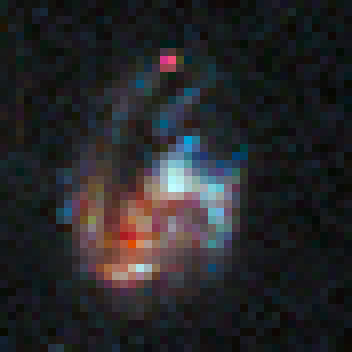by Chris Peterson » Mon May 05, 2014 5:06 pm
Ann wrote:Judging from how I read the caption, the host galaxy can actually be seen in this picture, and it appears to be much less red (or magenta) than the supernova. The best explanation I can think of is that the supernova created an incredible amount of either infrared or redshifted visible light, but not very much UV light. The galaxy, on the other hand, emits a lot of UV light, which is seen as blue, yellow and orange light in today's APOD.
Here's a careful enlargement from the color managed original:

- tiberius.jpg (9.97 KiB) Viewed 6128 times
The supernova itself shows 46% of its total energy emitted from 491-748 nm, 25% of its total energy emitted from 362-397 nm, and 29% of its total energy emitted from 203-292 nm. That makes the UV component a little high, perhaps, but this seems largely consistent with most supernovas.
The galaxy itself is a little harder to figure. Most of it is highly red biased, which is absolutely normal, meaning that the emitted light was substantially white (as is the case with virtually all galaxies). The blue edge, however, has most of its energy emitted in UV. Perhaps this galaxy is actually a pair in collision, or something else is going on producing a front of intense star formation. Even so, I'd expect more intensity in the visible than the IR, so something odd is happening there.
[quote="Ann"]Judging from how I read the caption, the host galaxy can actually be seen in this picture, and it appears to be much less red (or magenta) than the supernova. The best explanation I can think of is that the supernova created an incredible amount of either infrared or redshifted visible light, but not very much UV light. The galaxy, on the other hand, emits a lot of UV light, which is seen as blue, yellow and orange light in today's APOD.[/quote]
Here's a careful enlargement from the color managed original:
[attachment=0]tiberius.jpg[/attachment]
The supernova itself shows 46% of its total energy emitted from 491-748 nm, 25% of its total energy emitted from 362-397 nm, and 29% of its total energy emitted from 203-292 nm. That makes the UV component a little high, perhaps, but this seems largely consistent with most supernovas.
The galaxy itself is a little harder to figure. Most of it is highly red biased, which is absolutely normal, meaning that the emitted light was substantially white (as is the case with virtually all galaxies). The blue edge, however, has most of its energy emitted in UV. Perhaps this galaxy is actually a pair in collision, or something else is going on producing a front of intense star formation. Even so, I'd expect more intensity in the visible than the IR, so something odd is happening there.